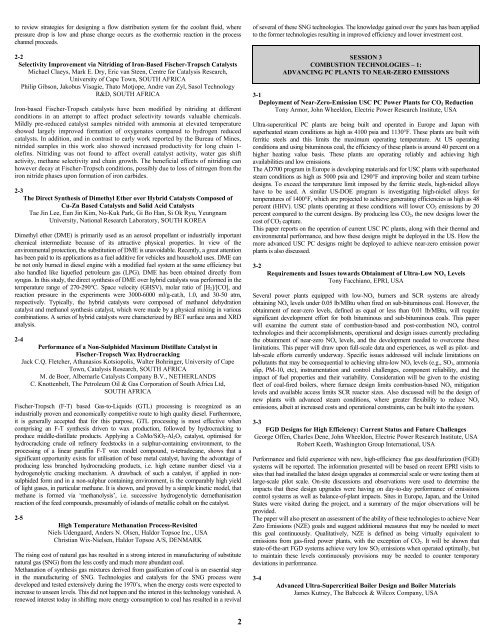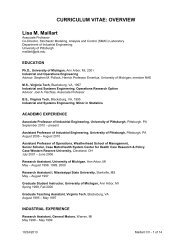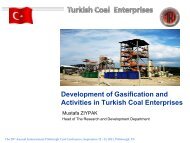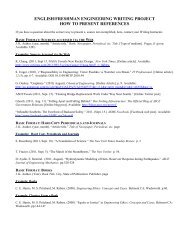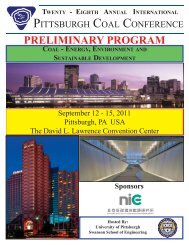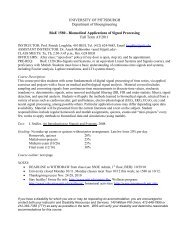Abstract Booklet 2006 - Swanson School of Engineering - University ...
Abstract Booklet 2006 - Swanson School of Engineering - University ...
Abstract Booklet 2006 - Swanson School of Engineering - University ...
Create successful ePaper yourself
Turn your PDF publications into a flip-book with our unique Google optimized e-Paper software.
to review strategies for designing a flow distribution system for the coolant fluid, where<br />
pressure drop is low and phase change occurs as the exothermic reaction in the process<br />
channel proceeds.<br />
2-2<br />
Selectivity Improvement via Nitriding <strong>of</strong> Iron-Based Fischer-Tropsch Catalysts<br />
Michael Claeys, Mark E. Dry, Eric van Steen, Centre for Catalysis Research,<br />
<strong>University</strong> <strong>of</strong> Cape Town, SOUTH AFRICA<br />
Philip Gibson, Jakobus Visagie, Thato Motjope, Andre van Zyl, Sasol Technology<br />
R&D, SOUTH AFRICA<br />
Iron-based Fischer-Tropsch catalysts have been modified by nitriding at different<br />
conditions in an attempt to affect product selectivity towards valuable chemicals.<br />
Mildly pre-reduced catalyst samples nitrided with ammonia at elevated temperature<br />
showed largely improved formation <strong>of</strong> oxygenates compared to hydrogen reduced<br />
catalysts. In addition, and in contrast to early work reported by the Bureau <strong>of</strong> Mines,<br />
nitrided samples in this work also showed increased productivity for long chain 1-<br />
olefins. Nitriding was not found to affect overall catalyst activity, water gas shift<br />
activity, methane selectivity and chain growth. The beneficial effects <strong>of</strong> nitriding can<br />
however decay at Fischer-Tropsch conditions, possibly due to loss <strong>of</strong> nitrogen from the<br />
iron nitride phases upon formation <strong>of</strong> iron carbides.<br />
2-3<br />
The Direct Synthesis <strong>of</strong> Dimethyl Ether over Hybrid Catalysts Composed <strong>of</strong><br />
Cu-Zn Based Catalysts and Solid Acid Catalysts<br />
Tae Jin Lee, Eun Jin Kim, No-Kuk Park, Gi Bo Han, Si Ok Ryu, Yeungnam<br />
<strong>University</strong>, National Research Laboratory, SOUTH KOREA<br />
Dimethyl ether (DME) is primarily used as an aerosol propellant or industrially important<br />
chemical intermediate because <strong>of</strong> its attractive physical properties. In view <strong>of</strong> the<br />
environmental protection, the substitution <strong>of</strong> DME is unavoidable. Recently, a great attention<br />
has been paid to its applications as a fuel additive for vehicles and household uses. DME can<br />
be not only burned in diesel engine with a modified fuel system at the same efficiency but<br />
also handled like liquefied petroleum gas (LPG). DME has been obtained directly from<br />
syngas. In this study, the direct synthesis <strong>of</strong> DME over hybrid catalysts was performed in the<br />
temperature range <strong>of</strong> 270-290°C. Space velocity (GHSV), molar ratio <strong>of</strong> [H 2 ]/[CO], and<br />
reaction pressure in the experiments were 3000-6000 ml/g-cat.h, 1.0, and 30-50 atm,<br />
respectively. Typically, the hybrid catalysts were composed <strong>of</strong> methanol dehydration<br />
catalyst and methanol synthesis catalyst, which were made by a physical mixing in various<br />
combinations. A series <strong>of</strong> hybrid catalysts were characterized by BET surface area and XRD<br />
analysis.<br />
2-4<br />
Performance <strong>of</strong> a Non-Sulphided Maximum Distillate Catalyst in<br />
Fischer-Tropsch Wax Hydrocracking<br />
Jack C.Q. Fletcher, Athanasios Kotsiopolis, Walter Bohringer, <strong>University</strong> <strong>of</strong> Cape<br />
Town, Catalysis Research, SOUTH AFRICA<br />
M. de Boer, Albemarle Catalysts Company B.V., NETHERLANDS<br />
C. Knottenbelt, The Petroleum Oil & Gas Corporation <strong>of</strong> South Africa Ltd,<br />
SOUTH AFRICA<br />
Fischer-Tropsch (F-T) based Gas-to-Liquids (GTL) processing is recognized as an<br />
industrially proven and economically competitive route to high quality diesel. Furthermore,<br />
it is generally accepted that for this purpose, GTL processing is most effective when<br />
comprising an F-T synthesis driven to wax production, followed by hydrocracking to<br />
produce middle-distillate products. Applying a CoMo/SiO 2 -Al 2 O 3 catalyst, optimised for<br />
hydrocracking crude oil refinery feedstocks in a sulphur-containing environment, to the<br />
processing <strong>of</strong> a linear paraffin F-T wax model compound, n-tetradecane, shows that a<br />
significant opportunity exists for utilisation <strong>of</strong> base metal catalyst, having the advantage <strong>of</strong><br />
producing less branched hydrocracking products, i.e. high cetane number diesel via a<br />
hydrogenolytic cracking mechanism. A drawback <strong>of</strong> such a catalyst, if applied in nonsulphided<br />
form and in a non-sulphur containing environment, is the comparably high yield<br />
<strong>of</strong> light gases, in particular methane. It is shown, and proved by a simple kinetic model, that<br />
methane is formed via ‘methanolysis’, i.e. successive hydrogenolytic demethanisation<br />
reaction <strong>of</strong> the feed compounds, presumably <strong>of</strong> islands <strong>of</strong> metallic cobalt on the catalyst.<br />
2-5<br />
High Temperature Methanation Process-Revisited<br />
Niels Udengaard, Anders N. Olsen, Haldor Topsoe Inc., USA<br />
Christian Wix-Nielsen, Haldor Topsoe A/S, DENMARK<br />
The rising cost <strong>of</strong> natural gas has resulted in a strong interest in manufacturing <strong>of</strong> substitute<br />
natural gas (SNG) from the less costly and much more abundant coal.<br />
Methanation <strong>of</strong> synthesis gas mixtures derived from gasification <strong>of</strong> coal is an essential step<br />
in the manufacturing <strong>of</strong> SNG. Technologies and catalysts for the SNG process were<br />
developed and tested extensively during the 1970’s, when the energy costs were expected to<br />
increase to unseen levels. This did not happen and the interest in this technology vanished. A<br />
renewed interest today in shifting more energy consumption to coal has resulted in a revival<br />
<strong>of</strong> several <strong>of</strong> these SNG technologies. The knowledge gained over the years has been applied<br />
to the former technologies resulting in improved efficiency and lower investment cost.<br />
SESSION 3<br />
COMBUSTION TECHNOLOGIES – 1:<br />
ADVANCING PC PLANTS TO NEAR-ZERO EMISSIONS<br />
3-1<br />
Deployment <strong>of</strong> Near-Zero-Emission USC PC Power Plants for CO 2 Reduction<br />
Tony Armor, John Wheeldon, Electric Power Research Institute, USA<br />
Ultra-supercritical PC plants are being built and operated in Europe and Japan with<br />
superheated steam conditions as high as 4100 psia and 1130°F. These plants are built with<br />
ferritic steels and this limits the maximum operating temperature. At US operating<br />
conditions and using bituminous coal, the efficiency <strong>of</strong> these plants is around 40 percent on a<br />
higher heating value basis. These plants are operating reliably and achieving high<br />
availabilities and low emissions.<br />
The AD700 program in Europe is developing materials and for USC plants with superheated<br />
steam conditions as high as 5000 psia and 1290°F and improving boiler and steam turbine<br />
designs. To exceed the temperature limit imposed by the ferritic steels, high-nickel alloys<br />
have to be used. A similar US-DOE program is investigating high-nickel alloys for<br />
temperatures <strong>of</strong> 1400°F, which are projected to achieve generating efficiencies as high as 48<br />
percent (HHV). USC plants operating at these conditions will lower CO 2 emissions by 20<br />
percent compared to the current designs. By producing less CO 2 , the new designs lower the<br />
cost <strong>of</strong> CO 2 capture.<br />
This paper reports on the operation <strong>of</strong> current USC PC plants, along with their thermal and<br />
environmental performance, and how these designs might be deployed in the US. How the<br />
more advanced USC PC designs might be deployed to achieve near-zero emission power<br />
plants is also discussed.<br />
3-2<br />
Requirements and Issues towards Obtainment <strong>of</strong> Ultra-Low NO x Levels<br />
Tony Facchiano, EPRI, USA<br />
Several power plants equipped with low-NO x burners and SCR systems are already<br />
obtaining NO x levels under 0.05 lb/MBtu when fired on sub-bituminous coal. However, the<br />
obtainment <strong>of</strong> near-zero levels, defined as equal or less than 0.01 lb/MBtu, will require<br />
significant development effort for both bituminous and sub-bituminous coals. This paper<br />
will examine the current state <strong>of</strong> combustion-based and post-combustion NO x control<br />
technologies and their accomplishments, operational and design issues currently precluding<br />
the obtainment <strong>of</strong> near-zero NO x levels, and the development needed to overcome these<br />
limitations. This paper will draw upon full-scale data and experiences, as well as pilot- and<br />
lab-scale efforts currently underway. Specific issues addressed will include limitations on<br />
pollutants that may be consequential to achieving ultra-low NO x levels (e.g., SO 3 , ammonia<br />
slip, PM-10, etc), instrumentation and control challenges, component reliability, and the<br />
impact <strong>of</strong> fuel properties and their variability. Consideration will be given to the existing<br />
fleet <strong>of</strong> coal-fired boilers, where furnace design limits combustion-based NO x mitigation<br />
levels and available access limits SCR reactor sizes. Also discussed will be the design <strong>of</strong><br />
new plants with advanced steam conditions, where greater flexibility to reduce NO x<br />
emissions, albeit at increased costs and operational constraints, can be built into the system.<br />
3-3<br />
FGD Designs for High Efficiency: Current Status and Future Challenges<br />
George Offen, Charles Dene, John Wheeldon, Electric Power Research Institute, USA<br />
Robert Keeth, Washington Group International, USA<br />
Performance and field experience with new, high-efficiency flue gas desulfurization (FGD)<br />
systems will be reported. The information presented will be based on recent EPRI visits to<br />
sites that had installed the latest design upgrades at commercial scale or were testing them at<br />
large-scale pilot scale. On-site discussions and observations were used to determine the<br />
impacts that these design upgrades were having on day-to-day performance <strong>of</strong> emissions<br />
control systems as well as balance-<strong>of</strong>-plant impacts. Sites in Europe, Japan, and the United<br />
States were visited during the project, and a summary <strong>of</strong> the major observations will be<br />
provided.<br />
The paper will also present an assessment <strong>of</strong> the ability <strong>of</strong> these technologies to achieve Near<br />
Zero Emissions (NZE) goals and suggest additional measures that may be needed to meet<br />
this goal continuously. Qualitatively, NZE is defined as being virtually equivalent to<br />
emissions from gas-fired power plants, with the exception <strong>of</strong> CO 2 . It will be shown that<br />
state-<strong>of</strong>-the-art FGD systems achieve very low SO 2 emissions when operated optimally, but<br />
to maintain these levels continuously provisions may be needed to counter temporary<br />
deviations in performance.<br />
3-4<br />
Advanced Ultra-Supercritical Boiler Design and Boiler Materials<br />
James Kutney, The Babcock & Wilcox Company, USA<br />
2


